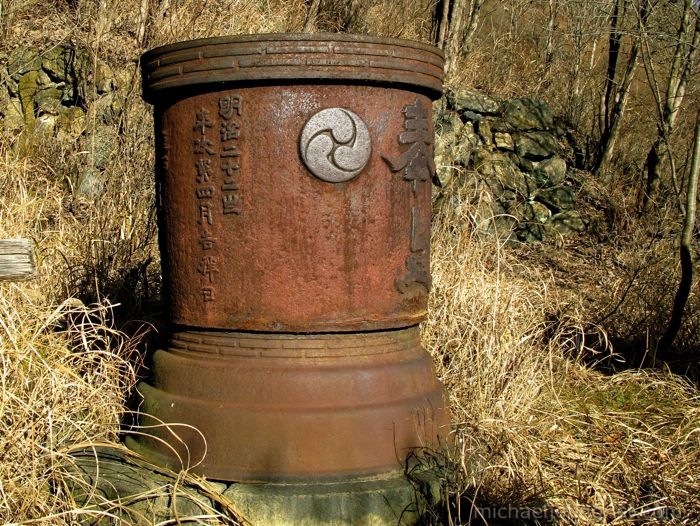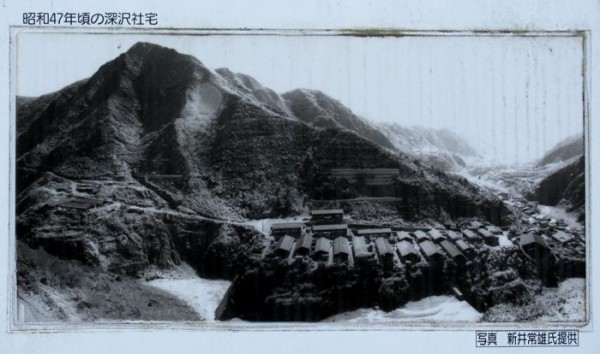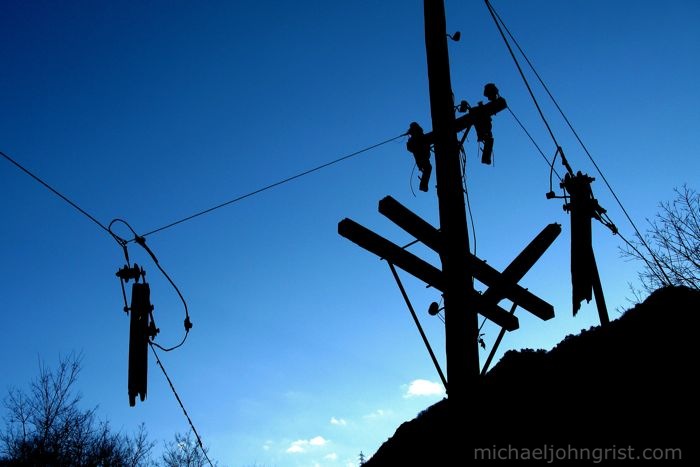Life in Ashio would never have been easy, and certainly not at the peak of production around 1910 when 39,000 people called it home. Crammed into a narrow river valley, blasted by freezing winter winds while living in uninsulated plywood apartments, many would have turned to the ‘kamisama’ or Gods for spiritual succor.

Japanese religious beliefs are a little complex- ask most people here what their religion is and they’ll say they have none. To judge from that and popular culture, the country seems remarkably secular. There is no institute with regular services like Church, there is no one book of mythology and rules like the Bible, no central leader like the Pope. Religion in Japan is more of an ethereal thing, hard to pin down but most definitely there, its ceremonies done without really considering them ‘religion’, they’re more just part of traditional family life.
There are Shinto and Buddhist traditions in Japan, as well as a form of ancestor worship. It’s important to remember also that until the Second World War in the Pacific theater ended in Japan’s surrender- the Emperor was considered a living God and worshipped as such. Religion was a huge deal. The War was pitched to the Japanese as for the greater glory of the Emperor. When he surrendered and proclaimed himself not a God- that was an immense blow to the Japanese psyche- they most sincerely lost their way. To some extent, I think they still haven’t found it.
That aside- I’ve wanted to find an abandoned temple/shrine or some time- so was very pleasantly surprised to stumble upon this one. Su Young and I had already explored the power station and mine buildings (part 3), then spotted a half-masked red shrine gate (tori) up some stone stairs.
The actual shrine buildings were scarcely visible through the scraggly brush- but we climbed a nearby hill and saw the trademark heavy slate roof, then went back down, circum-navigated the collapsed bridge (Su Young wanted to try walking across it, but she’s fearless- I suggested we walk around), and climbed up the loose-earth hill-side to be met with numerous stone lanterns and great copper vats.

We climbed up the disheveled stone steps, nearly stumbling over unsteady footing a few times, and walked around the main building, and a second one behind it. We were able to go inside both, but there was very little to see- wooden rooms with a few bits of furniture and ceremonial bits and pieces.
The second building at the top had a small plastic wallet just inside the open doorway, sheltered by the structures wide eaves, filled with 4 or 5 note books- each dated and filled out with comments from visitors. The notebooks stretched back over 15 years, with a few comments in English and one in French.
Of course I had to add my own comment, you can see it in the gallery below. Su Young added her own in Korean after me too. The ‘Kings of the Copper Mountains’ reference is because we’re in the copper mountains- dozan 銅山- and there’s a book I loved as a kid called ‘The King of the Copper Mountains‘ by Paul Biegel, about a beloved King who is dying, but kept alive by stories from the animals in his kingdom while a gnome adventures to find a fabled medicine to save his life.
We spent a little time in silence under the eaves of the shrine, looking out over the valley, trying to imagine what life might have been like when the factories were in full-flow, spewing fumes out over the clear blue sky. It was tough.
Then we descended. We went inside the factory and the train station, then took a final turn up to the old apartments, which had once earned Ashio the nickname ‘town of 1,000 houses.’

I’ve seen lots of fallen Japanese apartments before, but was astonished afresh by these, by how feebly thin the walls were- basically plyboard screens less than a centimeter thick.
I can’t imagine they had any insulating powers at all- at best they acted as wind-breaks. It must have been freezing in the winter inside. I can imagine families huddling together around their one stove under blankets while they ate, probably shivering, then drifting into a chilly sleep, all bundled together round the dying embers of the fire.

After walking around the broken apartments for a while, the coming chill of night sinking into my bones, I felt not only a deep sympathy for the hard lives of the people who lived there, but also gratitude for the ease of my life.

Then, like any tourist, I put my camera away and started the journey home.
CONTENTS
Ashiodozan Mining Town- 1. History and Relics
Ashiodozan Mining Town- 2. Shrine and Apartments
Ashiodozan Mining Town- 3. Power Hub and Mine Complex
Ashiodozan Mining Town- 4. Train Station and Factory
You can see all MJG’s Ruins / Haikyo explorations here:
[album id=4 template=compact]

Comments 20
really nice photographs, learned a lot and they really add to the post
That shrine is incredible. Even though it appears to be just an empty building, it still is amazing to see that shrine sitting up there lonely on the hill. Odd how those first steps appeared to be maintained. Maybe someone should fix the shrine up and live there.
Author
Jamaipanese- Thanks a lot.
Tornadoes- I know, it was quite impressive to stumble on. I was worried after seeing it that it might not actually be abandoned, as just another shrine is not so impressive. But this one really was. Live there, well, it’s a bit out of the way, but sure- you could.
OMG mike, i got your blog link
from the mike blender blog
and i really enjoy reading your blog
especially the haikyo part
if i ever went to japan or live there (hopefully)
can i join your haikyo trip?
and do Su Young got a blog?
Very interesting indeed. Just the kind of place I would want a movie to start at. 🙂
Speaking of movies, fireswamps is a reference to “the Princess Bride”. One of my favorite movies.
Awesome pictures, I hope to see something similar one day.
And for some reason the Princess Bride is on my mind…??
looks like a scene from one of the japanese film I saw.
Author
Nathan- That’s great, thanks a lot. Sure thing you can join on a haikyo- I used to be pretty guarded about having ‘guests’ come along, but am getting increasingly open to it now. Though- the true impact of a haikyo doesn’t really hit unless you go alone. So, it’s a trade-off really. Su Young has a blog yes, but it’s all in Korean- you can see the link in my sidebar under Friends.
Ed- Princess Bride, good call, one of my favorites also. And true- these places would make great film sets. Have you seen Battle Royale? I’m trying to hunt down some of the locations they used to shoot that.
Shannon- Thanks, and nice call on the Princess Bride.
Jesse- True that, they do go in for post-apocalypse here- which film are you thinking of?
It was Godzilla!!!
It looks like Saskatchewan
Very interesting set of photos. We usually see Japanese temples in all their splendor. Seeing an abandoned one is original.
Author
Wonderboy- Darn tootin!
Ellen- I’ll have to go search for some Saskatchewan images then- thanks.
Stefan- Right, I’ve been looking for one of these for a while now- glad it stands out.
This is pretty cool!
But most importantly…
I see you have referenced Labyrinth (bog of eternal stench) here. I’d like to let you know that that completely made my day and I love you for it.
Love the references and the pictures! I spent 5 years in Japan, and exploring abandoned places was one of my favorite things to do. I wish I could have made it out to Ashio to see this for myself. Thanks for sharing!
Seeing these abandoned areas always gives me a sense of sadness. Great photos though!
Woah, you were there on Pearl Harbor Day.
Author
Jess- Glad you caught that 🙂 Here’s another- boom, David Bowie in too-tight pants! (shudders…)
Lisa- Thanks so much! And I’d be very interested to hear what places you explored, do you have any photos online? Also care to share any of them?
Japanese words- Me too, and thanks.
Nate- Is that right? I guess that is meaningful somehow, since copper from this place would have definitely fuelled the war effort.
“…there is no one book of mythology and rules like the Bible…”
HAHAHAAHA! Your ignorance is laughable at best.
Author
if there is one, name it.
Koran for one. Any Greek, Japanese, Chinese, Indian, etc…mythological books. There are plenty.